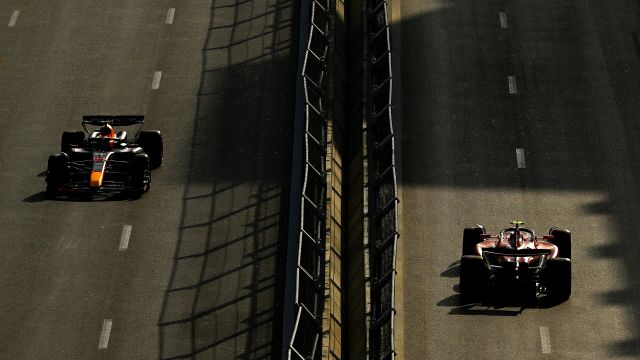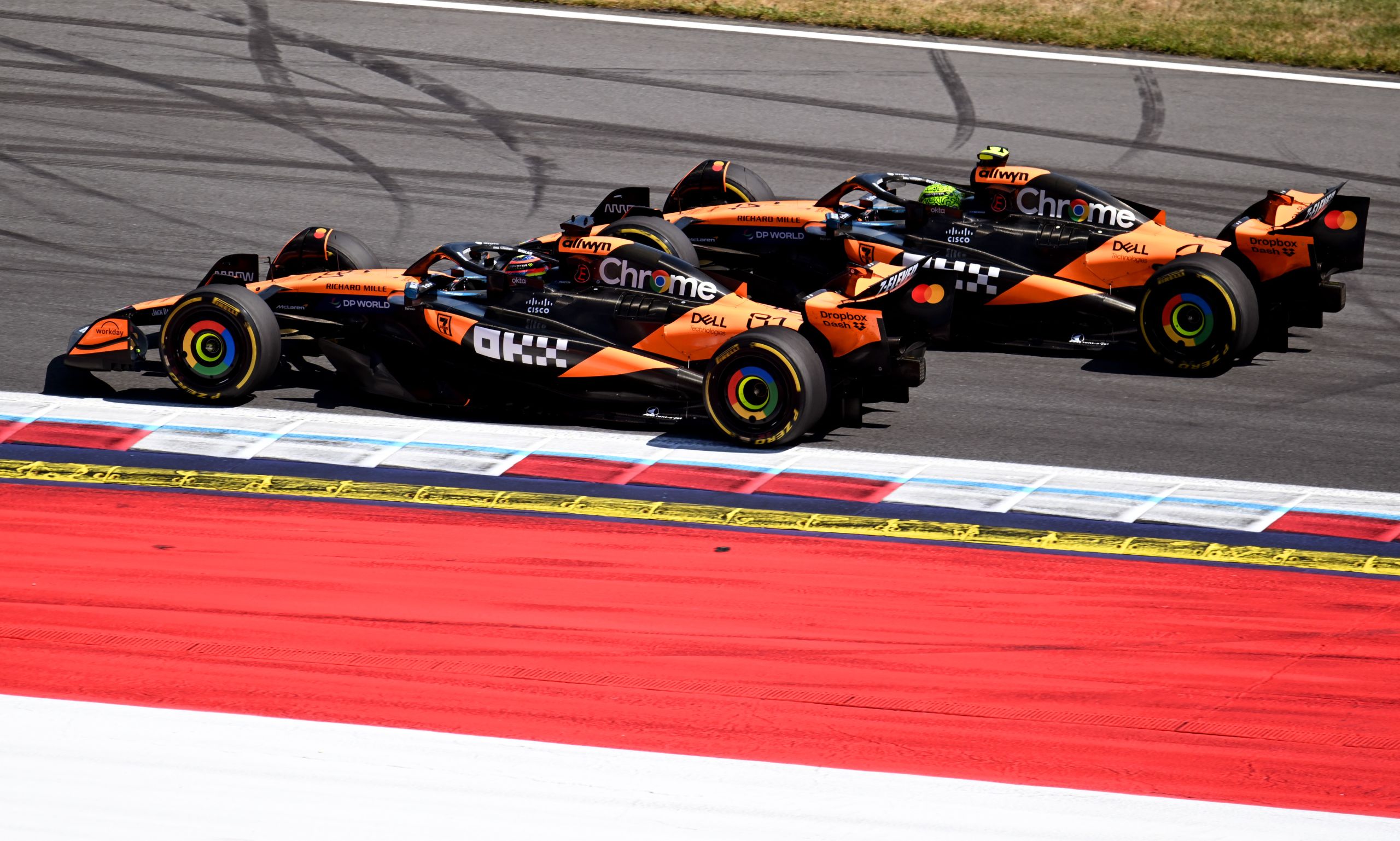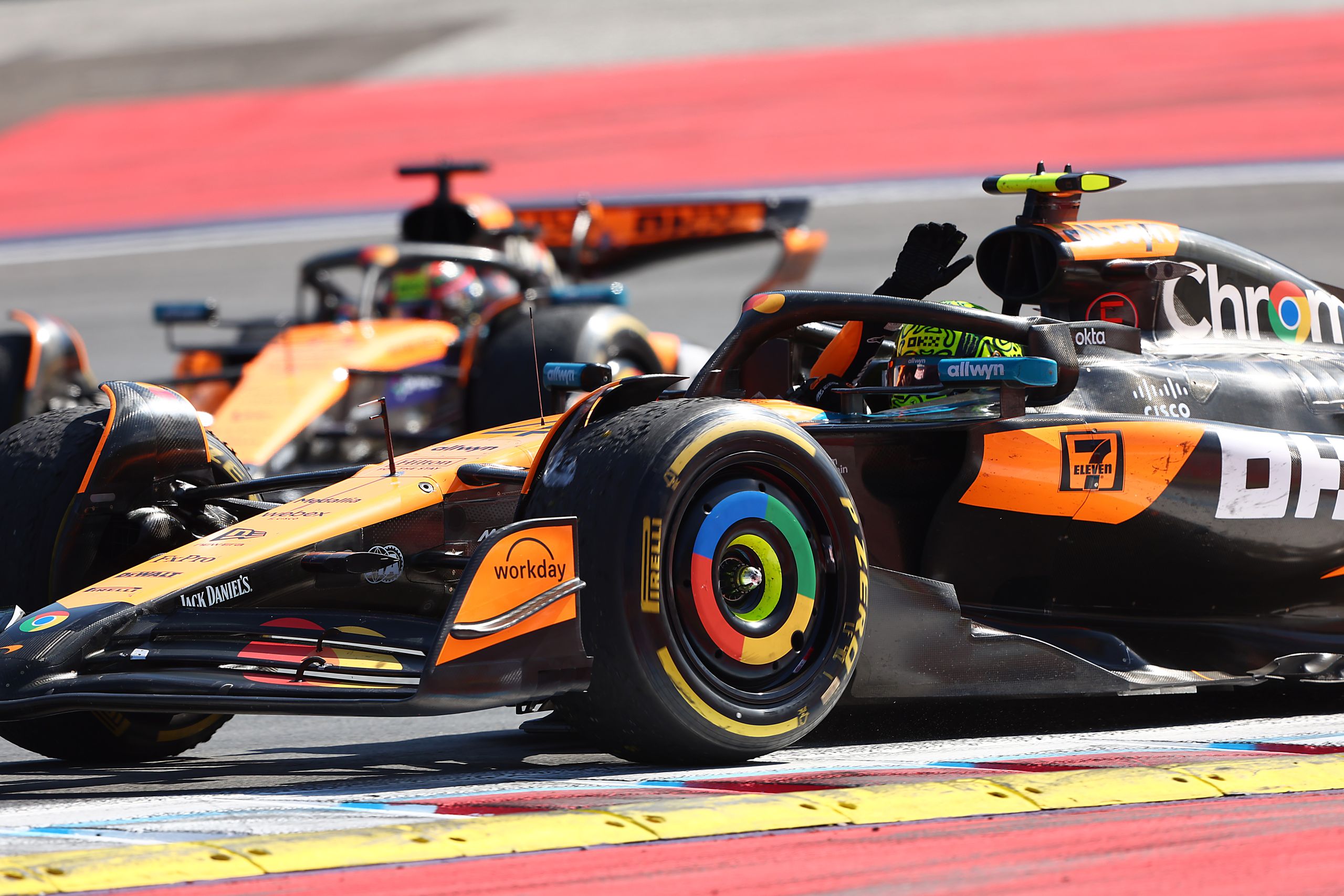How Do Formula 1 Cars Generate Downforce?


Formula 1 cars generate downforce through sophisticated aerodynamic designs that push the vehicle towards the track. These high-performance machines can produce more than twice their weight in downforce, allowing them to corner at incredible speeds.
The primary sources of downforce in F1 cars are complex floor designs, wings, and other aerodynamic elements. The floor uses ground effect principles to create a low-pressure area beneath the car, effectively sucking it to the track. Front and rear wings work in tandem to shape airflow over and around the car, further increasing downforce.
At speeds around 150 km/h, an F1 car generates downforce equal to its own weight. As speeds increase, so does the downforce, reaching two to three times the car’s weight at maximum velocity. This invisible force is crucial for F1 performance, enabling drivers to push the limits of speed and handling through corners.
The Role of Downforce in F1 Racing
Downforce plays a critical role in Formula 1 racing, enhancing car performance and enabling high-speed cornering. This aerodynamic force dramatically impacts a car’s grip, stability, and overall handling capabilities on the track.
Understanding Downforce
Downforce is an aerodynamic force that pushes the car downward, increasing its grip on the track. It works opposite to lift, pressing the car into the ground rather than lifting it up. F1 cars generate downforce through specially designed body shapes, wings, and underbody elements.
As an F1 car moves faster, it creates more downforce. This increased downward pressure allows the tires to maintain better contact with the track surface. The result is improved traction, which is essential for acceleration, braking, and cornering at high speeds.
F1 engineers constantly work to maximize downforce while minimizing drag, aiming to find the optimal balance for each track and race condition.
Impact on Performance
Downforce significantly boosts F1 car performance in several ways. It allows cars to achieve faster lap times by improving cornering speeds and stability.
With increased downforce, drivers can brake later before turns and accelerate earlier when exiting them. This translates to quicker lap times and better racing performance.
Downforce also enhances tire grip, which is crucial for maintaining control at high speeds. Better grip leads to improved acceleration and more efficient power transfer from the engine to the track.
The aerodynamic pressure created by downforce helps cool the brakes and engine, contributing to better overall car performance and reliability during races.
Cornering Speeds and Handling
Downforce has a profound effect on an F1 car’s cornering abilities. It allows cars to maintain higher speeds through turns that would otherwise be impossible.
As cars enter a corner, downforce helps prevent sliding by pushing the tires firmly against the track. This increased grip allows drivers to take turns at speeds that can exceed 150 mph in some cases.
The extra downward force also improves car stability, reducing the risk of spins or loss of control during high-speed maneuvers. This stability gives drivers more confidence to push their limits in challenging corners.
Balancing downforce across the front and rear of the car is key to achieving good handling. Too much front downforce can cause understeer, while excess rear downforce may lead to oversteer. F1 teams fine-tune this balance for each track to optimize cornering performance.
Aerodynamic Elements of F1 Cars
Formula 1 cars utilize various aerodynamic components to generate downforce. These elements work together to improve grip, stability, and overall performance on the track.
Front Wings and Airflow
The front wing is the first aerodynamic element to interact with oncoming air. It splits the airflow, directing it over and around the car. F1 front wings feature complex designs with multiple elements and flaps. These components create low-pressure areas underneath the wing, pulling the car towards the ground.
Front wings also manage airflow to other parts of the car. They guide air around the tires and towards the sidepods and floor. This helps reduce drag and improves the efficiency of downstream aerodynamic elements.
Engineers constantly refine front wing designs to maximize downforce while minimizing drag. Small changes in wing angle or shape can have significant impacts on overall car performance.
Rear Wings and Drag
Rear wings play a crucial role in generating downforce and managing drag. These wings consist of a main plane and an adjustable flap. By altering the angle of the flap, drivers can modify the balance between downforce and straight-line speed.
The rear wing creates a high-pressure zone above and a low-pressure zone below, pushing the car down. This effect increases traction, especially in high-speed corners. However, rear wings also produce drag, which slows the car on straights.
F1 teams must find the right balance between downforce and drag for each track. Some circuits require higher downforce setups for better cornering, while others favor lower drag configurations for top speed.
Underbody Aerodynamics and Ground Effect
The floor and diffuser form a critical part of F1 car aerodynamics. These components harness the ground effect, creating a low-pressure area beneath the car. This suction effect significantly increases downforce without adding as much drag as wing-based systems.
F1 car floors feature complex shapes and channels to accelerate airflow. As air moves faster under the car, pressure drops, pulling the vehicle down. The diffuser at the rear helps manage this airflow, gradually slowing it to reduce drag.
Recent rule changes have increased the importance of underbody aerodynamics in F1. Teams now focus more on floor design to gain performance advantages while complying with regulations.
Additional Downforce Components
F1 cars employ several other aerodynamic elements to fine-tune performance.
Vortex generators create small air vortices that energize airflow. These devices help keep airflow attached to surfaces, enhancing the performance of wings and other elements.
Side skirts, though limited by current regulations, help seal the gap between the car’s floor and the track. This improves the effectiveness of ground effect aerodynamics.
Every surface of an F1 car is carefully shaped to contribute to overall aerodynamic performance. From wing mirrors to brake ducts, each component plays a role in managing airflow and generating downforce.
Engineering and Design
Formula 1 cars rely on sophisticated engineering and design to generate downforce. These elements work together to keep the cars glued to the track at high speeds.
Aerodynamics Engineering and CFD
Aerodynamics engineering plays a central role in F1 car design. Teams use computational fluid dynamics (CFD) to simulate airflow around the car. This technology allows engineers to test different designs virtually before building physical models.
Wind tunnel testing complements CFD simulations. Scale models are placed in wind tunnels to measure downforce and drag. Engineers analyze data from these tests to refine the car’s shape.
The front and rear wings are key components for generating downforce. Their angles and profiles are carefully designed to push the car down while minimizing drag. The floor and diffuser also create significant downforce through ground effect.
Material Science and Car Parts
F1 teams use advanced materials to build lightweight yet strong car parts. Carbon fiber composites are widely used for their high strength-to-weight ratio. This allows teams to create complex aerodynamic shapes without adding excessive weight.
Titanium and other exotic alloys find applications in specific components. These materials offer excellent strength and heat resistance properties.
Engineers constantly seek ways to improve the stiffness of car parts. This helps maintain the intended aerodynamic shape under high loads, maximizing downforce generation.
Regulations and Compliance
F1 has strict regulations governing car design and aerodynamics. These rules aim to control costs, promote safety, and maintain competitive balance.
Teams must comply with specific dimensions for various car parts. There are limits on the number and size of aerodynamic elements. The regulations also restrict the use of certain materials and manufacturing techniques.
Compliance checks are rigorous. Cars undergo thorough inspections before and after races. Any violations can result in penalties or disqualification.
Despite these constraints, F1 engineers constantly push the boundaries of innovation. They seek creative solutions within the rules to gain a competitive edge in downforce generation.
External Factors Affecting Downforce
Formula 1 cars generate downforce through careful aerodynamic design, but external conditions significantly impact its effectiveness. These factors can enhance or reduce a car’s grip and performance on the track.
Weather and Environmental Conditions
Air density plays a crucial role in downforce generation. Cooler air is denser, allowing wings and other aerodynamic surfaces to create more downforce. Hot conditions reduce air density, diminishing downforce levels.
Humidity affects air density as well. Higher humidity decreases air density, potentially lowering downforce. This can lead to reduced grip and slower cornering speeds.
Wind direction and speed influence aerodynamics. Headwinds increase effective airspeed over wings, boosting downforce. Tailwinds have the opposite effect, reducing downforce. Crosswinds can disrupt airflow patterns, altering the balance of downforce across the car.
Altitude impacts air density. At higher elevations, thinner air produces less downforce, challenging teams to adapt their aerodynamic setups.
Track Conditions and Tyres
Track surface characteristics greatly affect downforce generation. Smooth surfaces allow for consistent airflow underneath the car, maximizing ground effect. Bumpy or uneven tracks disrupt this airflow, reducing downforce.
Track temperature influences tyre performance and grip. Warmer surfaces generally provide better traction, working in conjunction with aerodynamic downforce to enhance cornering abilities.
Rubber buildup on the racing line can increase grip levels as the race progresses. This interacts with the car’s aerodynamics to modify overall downforce effectiveness.
Tyre compounds and wear patterns impact a car’s ability to utilize downforce. Softer compounds offer more grip but degrade faster, while harder compounds last longer but provide less traction. Teams must balance these factors with aerodynamic setups for optimal performance.
How Do Formula 1 Cars Generate Downforce? – FAQs
What is the downforce of a F1 car?
A modern Formula 1 car generates around 3.5 tons (7,700 lbs) of downforce at top speed. This is about 2-3 times the car’s weight, allowing it to corner at extremely high speeds. The exact amount varies based on the track layout and car setup.
What is the downforce at 200mph in F1?
At 200 mph (322 km/h), an F1 car produces approximately 2,200 lbs (1,000 kg) of downforce. This is still more than the car’s weight, enabling incredible cornering abilities even at this velocity. The downforce increases exponentially with speed.
What is the max F1 downforce?
The maximum downforce in F1 is not absolute as it depends on factors like car design and circuit characteristics. However, at top speeds of around 220 mph (354 km/h), an F1 car can generate up to 5 tons (11,000 lbs) of downforce, which is about 4-5 times its weight.
How many gs of downforce does an F1 car produce?
An F1 car experiences lateral g-forces of up to 6g during high-speed cornering, largely thanks to the immense downforce. This means the driver feels a force 6 times their body weight pressing them sideways. The downforce itself can reach 4-5g vertically at maximum speed.
How do different parts of an F1 car create downforce?
Down force is the force that presses the car on to the ground. This force is generated by using the air that is moving around the body of the car. To balance the down force between the front and rear of the car careful design of the bodywork of the car becomes essential. Car constructors achieve this by engineering design and aerodynamic trials.
While the front wings produce around 25 per cent of the down force, the rest of the bodywork contribute 5-10 per cent. The under body of the car and the diffusers produce the maximum amount of down force at 45 per cent. The rear of the car along with the rear wings contributes the balance of 25 per cent of down force.
How do the front and rear wings create downforce?
F1 front wings along with the splitter, canards and vortex generators contribute to at least 25 per cent of the downforce in a Formula One car. Front wings not only produce downforce but also streamline the flow of air around the car. As a leading part of the car, the front wing is the first component to disrupt the air.
Front wings use aerofoils to create downforce as well as regulate the flow of air around the car. The air is directed in such a way that it does not create a drag on interacting with the trailing parts of the car. Much of the air is directed toward the underbody to help it minimise the drag and create a downforce of its own. Air is directed toward the side pods for engine cooling and is kept away from the rear wings.
The rear wing of an F1 car contributes as much downforce as the front wings and balances the downward force of the car. The aerofoils in the rear wings are designed and shaped to maximise the downforce and minimise drag. The downforce and the drag created by the rear wing will depend on the track and the driving conditions and cars have different rear wings for different tracks.
Rear wings are adjustable; the angle of attack of the aerofoils can be adjusted to either minimise the drag or to increase the downforce. This gives the driver a chance to overtake and to increase the speed of the car on longer straights. The system is monitored by the FIA. A light in the cockpit tells the driver when he is eligible to change the angle of the aerofoils.
How do splitters, canards, vortex generators create downforce in the front?
Splitters, also called dams, are used to reduce the gap between the ground and the car. This ensures that very little air passes beneath the car reducing the lift induced. Most of the air is directed towards the side of the car and the rest towards the underbody. If a car underside is not very smooth, the airflow below the car turns very turbulent. This results in less drag on the car and might well contribute a little downforce of its own.
Canards and vortex generators are small plates that are attached at the front ends of the car. They are so fixed that their inclinations contribute to the downforce of the car in a small way. A badly inclined canard or vortex generator can affect the performance of other aerodynamic devices or the rear wings.
How do side skirts, side ducts and vortex generators create down force in the middle?
Side skirts primarily reduce the amount of high pressure on the sides of the car. This prevents the air from going under the car from the sides. If the air from the sides goes under the car it will diminish the ground effect and the down force created. The edge of the side skirts should be less than 2 cm from the ground. If the gap is too large, the effectiveness of the side skirts reduces drastically.
Side ducts facilitate the smooth flow of air along the side of the car. The air also helps in cooling the engine as well as in braking. The side skirts and the canards generate turbulent air in the front of the car. The smooth flow of the air through the side ducts ensures that the air does not interfere with the turbulent flow initiated by the side skirts and the canards. This helps in reducing the drag on the car and increases its velocity.
How do spoilers and diffusers create down force in the rear?
A spoiler is a plate attached to the body of the car that interrupts the smooth flow of air around the car. A flow of smooth air contributes to a lifting force. The spoiler interferes with this flow to spoil it. The turbulent flow in the wake of the spoiler either reduces the lift or cancels it to contribute to the car’s aerodynamics.
The rear spoiler on an F1 car creates turbulence just before the flow of the air. This turbulence causes the air to flow to move more slowly which causes a low pressure just in front of the spoiler plate. If a rear spoiler is correctly designed, it will not only eliminate the lift generated by the airflow but will contribute with down force of its own.
Diffusers are mostly located in the rear and after the wings and generate down force in the rear of a car. Diffusers help in reducing the pressure of the airflow under the car. In doing this, diffusers increase the velocity of the car. The increased velocity enables other components to produce more down force on the car.
How much down force do Formula 1 cars generate?
That is a really difficult question to answer because the downforce generated in cars vary. It is also the most closely guarded secret among teams. The reason for this is that a higher downforce gives the car greater cornering speed. This is a distinct advantage when entering a long straight. It helps the car overtake and leave the field behind.
From time to time the FIA brings in regulations to limit the downforce generated in cars and even out the competition. But whatever the FIA throws at teams, the best engineers in the business find a way around the rules and regulations. Generally, a formula one car speeding at 240 km per hour will produce a downforce of 2.5 Gs or more.
Between 2010 and 2013, Red Bull won four consecutive drivers’ and constructors’ championships with Sebastian Vettel driving the Red Bull RB6. Red Bull’s chief technical officer Adrian Newey promptly claimed that the Red Bull RB6 was “probably the car with the most downforce in the history of F1”. But he did not state the exact amount of downforce.
Romain Grosjean experienced claims that he experienced a downforce of 8 g at Suzuka in 2018. That means his 738 kg car weighed approximately more than 5904 kg at that time. Down force is a function of speed. The faster a car travels, the higher is the down force generated. Generally, Formula One cars produce a down force of 5 G’s.
Can a Formula 1 car drive upside down?
Modern Formula One cars develop as much as 5 Gs of downforce. In some instances, cars have produced much more downforce. Theoretically, it means that a car weighs five times its weight at that particular speed. That means a Formula One car could technically drive upside down in a long tunnel provided it attained the required speed before going upside down.
There are a few things to consider before a driver tries to drive his Formula One car upside down. Among them is the fuel supply to the engine. Also of concern is the lubrication of the engine. The most important thing is whether the driver will remain coordinated for the length of time that he is upside down in the cockpit of the car.
How will the engine get lubrication and fuel supply?
Lubrication of the engine should not be a problem because F1 cars are fitted with dry-sump engines. The oil is in an external tank and the oil outlet of the oil to the engine is not solely on the bottom of the tank. The oil is pumped from the external tank to the front of the engine and the engine should be fine in a short upside down run.
There is however the lateral G forces on the car which may force the oil towards one side of the tank. In this case, the engine may run dry. However, a modification of the plumbing of the oil system should solve this problem. The oil goes directly to the parts of the engine that need lubrication.
The same goes for the fuel supply system. A few modifications will do the trick and allow the car to drive upside down. The oil and fuel tanks have to be adequately filled to keep the engine from stalling. Fuel and oil supply systems in aeroplanes allow them to fly upside down and these systems can be implemented in an F1 car.
A regular Formula One car will however find it difficult to stay on the roof of a tunnel for a substantial length of time. If the engine stalls at an inopportune time, the consequences could be disastrous for both the driver and the car.
Will the driver be able to drive the car upside down?
Planes do summersaults and fly upside down for more than a few seconds. The question is will a Formula One car driver get disoriented when driving upside down? Will he be able to manoeuvre the car and bet it safely on the ground? Will the blood rush to the brain despite the down force and render the driver incapable of handling the car.
In any case, the tunnel that a driver attempts an upside-down ride should not be too high. At the same time, the car has to be cushioned at the top to account for a crash landing if things get out of hand. An astronaut who is used to weightlessness or even an air pilot could manage to drive a car upside down. They will have to first master the cockpit of an F1 car for there is no coming back once you are upside down.





